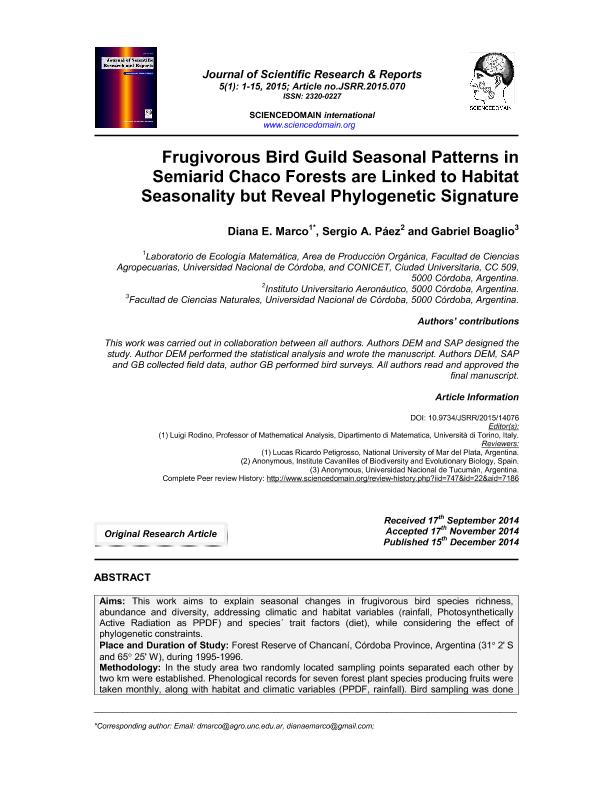Artículo
Frugivorous Bird Guild Seasonal Patterns in Semiarid Chaco Forests are Linked to Habitat Seasonality but Reveal Phylogenetic Signature
Fecha de publicación:
12/2014
Editorial:
ScienceDomain International
Revista:
Journal of Scientific Research and Reports
ISSN:
2320-0227
Idioma:
Inglés
Tipo de recurso:
Artículo publicado
Clasificación temática:
Resumen
Aims: This work aims to explain seasonal changes in frugivorous bird species richness, abundance and diversity, addressing climatic and habitat variables (rainfall, Photosynthetically Active Radiation as PPDF) and species´ trait factors (diet), while considering the effect of phylogenetic constraints. Place and Duration of Study: Forest Reserve of Chancaní, Córdoba Province, Argentina (31º 2' S and 65º 25' W), during 1995-1996. Methodology: In the study area two randomly located sampling points separated each other by two km were established. Phenological records for seven forest plant species producing fruits were taken monthly, along with habitat and climatic variables (PPDF, rainfall). Bird sampling was done monthly. Fourteen transects, each of 50 m long were permanently marked from randomly located points in N-S direction. While slowly walking along each transect, all bird sightings as well as hearings both to right and left sides were recorded. The bird species and the vegetation stratum where the sighting occurred were also recorded. Statistical Analysis: For all the bird species and for frugivorous species, bird species richness (S), species abundance as sightings, diversity (Shannon Index H´) and evenness (H´/lnS) were calculated for each sampling date. Friedman test was used to test differences in species richness and sightings among dates. For frugivorous bird data analysis, two approaches were used, one with the species values taken as independent data points, and the other removing phylogenetic effects by means of the analysis of independent contrasts. Categorical Principal Component Analysis (CATPCA) was used to explore the relationships among species dates of sighting initiation, duration of the sighting period and abundances at peak dates, using species values and independent contrasts. CATPCA (with species values) was also used to explore the relationships among frugivorous bird species richness, abundance and diversity, and climatic (rainfall) and habitat (PPDF and fruit abundance) variables. Results: A total of 67 species were recorded during the sampling period. Richness rose in spring, peaked during summer and then declined smoothly to winter. In contrast, abundance maintained fluctuating values during the sampling period, with a small peak in autumn. There were no significant differences in vegetation strata occupancy by different species of birds, although some groups showed a degree of preference. Considering frugivorous birds, a total of 29 frugivorous species were recorded during the sampling period. The temporal trend of species richness and diversity was similar to the pattern showed by all the species, although abundance showed a bimodal trend. CATPCA using species values and independent contrasts showed common overall results for the variables initiation and maximum of frugivorous species abundance, that were inversely or not correlated with duration of sightings, maximum abundance and total abundance along the sampling period. However, the behaviour of the variable Diet changed when independent contrasts were used. From a closer relationship with sighting initiation and peak and a greater importance with species values data, Diet showed a more distant relationship with these sightings variables and a negligible value when independent contrasts were used. Besides, using independent contrasts many species were differently related with the variables and the dispersion of the species was greater in the ordination space. Regarding climatic and habitat variables, rainfall and PPDF showed an overall similar seasonal pattern, although PPFD began rising earlier during the dry season. Rainfall and PPDF were temporally correlated. Fruits began appearing in spring, peaked during this season, and then decreased sharply to disappear during winter. Fruit abundance was highly correlated with PPFD but not with rainfall. CATPCA of climatic, habitat, and frugivorous bird variables (richness, abundance and diversity) separated spring, summer and autumn sampling dates from the last autumn date and winter dates. PPDF and fruit abundance explained most of the variance in bird richness and diversity but not in abundance. Rainfall did not explain the behaviour of any bird variable. Conclusion: We conclude that habitat characteristics, mainly PPFD and fruit abundance, are shaping the seasonal species composition (richness and diversity), although not abundance, of frugivorous bird assemblages in semiarid Chaco forests. The importance of the frugivorous diet diversification, as a species´ trait factor that could be contributing to shape the seasonal arrangement of frugivorous birds, was secondary and mainly related to the timing of appearance in the favourable season. However, even this modest contribution of diet diminished when the phylogeny were taken into account, showing a strong phylogenetic signal.
Archivos asociados
Licencia
Identificadores
Colecciones
Articulos(IDEA)
Articulos de INSTITUTO DE DIVERSIDAD Y ECOLOGIA ANIMAL
Articulos de INSTITUTO DE DIVERSIDAD Y ECOLOGIA ANIMAL
Citación
Boaglio, Gabriel Ivan; Páez, Sergio Aristóbulo; Marco, Diana Elizabeth; Frugivorous Bird Guild Seasonal Patterns in Semiarid Chaco Forests are Linked to Habitat Seasonality but Reveal Phylogenetic Signature; ScienceDomain International; Journal of Scientific Research and Reports ; 5; 1; 12-2014; 1-15
Compartir
Altmétricas




